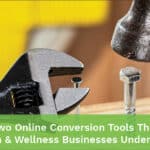Marketing copy only an engineer could love, a website that makes it hard to buy, plus images of only the super-fit. Bad, bad, bad marketers!
A picture caught my eye in today’s e-mail issue of Club Industry’s Fitness Business Pro. It pictured several adults – different ages, weights, ethnic background, etc. – next to an article listing workout wear from Nautilus Apparel as a hot trend for 2007. Background: Nautilus has launched four groups of workout wear – compression, active (less fitted), relaxed (even less fitted) and transit (to/from the gym or yoga studio, presumably).
My immediate reaction was “Cool!” They get it! People DO need stuff to work out in, but they also don’t necessarily want to run around in their car wearing just their workout clothes. Finally (I thought) somebody’s putting out a line of fitness wear that takes advantage of stuff like wicking fabrics, odor-resistance, and so forth…but styled for folks who don’t care to wear skin-tight clothes, regardless of their weight and fitness level. How smart! And so clever to show people of all sizes and ages wearing this stuff!
I immediately bopped over to their site – and was immediately disappointed. Why, oh why, do the big names in workout wear stay in this marketing rut?
First, the site has almost no pictures of anyone actually wearing these new clothes. It’s just photos of the garments. Gives you no sense of how they fit, for example. The few pictures they DO have are of the usual super-fit and young man and woman (no dark-skinned people here, by the way. I suppose the diversity in the original picture I mentioned was the exception).
Next, while they list these four new categories of clothing, they don’t explain the differences among the four groups anywhere. Yet many exercisers don’t know what compression clothing is. And the compression/active/relaxed distinction isn’t obvious, either. Surely explaining the different “fits” would be helpful to potential buyers! Lands End, for example, does a great job of this with its “classic”, “natural”, etc., fit descriptions.
Then, the introductory text on the main pages is much too fluffy – not much substance there. Nor does it appeal to the emotional element of the buying equation.
And most of the website copy reads as if it were written by a textile engineer, not someone who actually talks to customers and understands how they buy. For example, here’s the description of the “Relaxed Training Short” for women:
“A neutral rise relaxed fit short with articulated panels for full range of movement”
What the heck is a neutral rise? What are articulated panels? How about something more useful, like the inseam measurement?! What’s it made of? Will it dry quickly? Is it available in colors? How about plus sizes? Does it have a pocket? In fact, how about showing it on a real person and telling us her height and weight so we get a feel for how it would look on US?
Now, if you click through to the product detail page, you get some (not all) of these details. But all of that assumes that you saw enough that interested you on the initial product page to keep going.
This is a great example of how NOT to sell on the web. Don’t make your customers click to a second page for key information that you could easily provide them on the original page. This smacks of not knowing your customers’ key buying criteria.
And they never did explain what an articulated panel or a neutral rise was, and why as a potential buyer I would care. The rule here: every bit of your advertising/marketing copy, whether on your website or elsewhere, must answer the WIIFM question. What’s in it for me? Why, as a potential buyer, should I care about this aspect of your product. Think in terms of benefits, product advantages, emotional considerations….not baffling features like neutral rises and articulated panels.
I’ll also note that there’s a lengthy section on the site that delves into “apparel technology”. Can’t help but wonder how many customers said this was a key buying consideration. My guess is none. And if it IS key buying information, then why is it buried over here? It should be incorporated into the product listings. Website visitors have the attention span of a gnat. You can’t expect them to stroll through all the nooks and crannies of your site.
Sites like this could benefit from the approach that online retailers like Zappos (shoes) and catalog/online retailer J. Marco use. Zappos offers a great search ability – and really, wouldn’t it be great if consumers could say “show me all your shorts with an inseam greater than 4 inches”? J. Marco does a terrific job of actually providing vast quantities of details about fit, fabric and care for each garment.
The other lesson to be learned is to keep your marketing consistent. If you’re going to show a diverse group of people in some of your advertisements, your website should maintain that same look and feel.
PS OK, one last gripe. Why does this site use Flash? It doesn’t add a thing to the buying experience, it slows things down, and requires visitors to have the latest Flash plugin. Bad, bad, bad site design!



